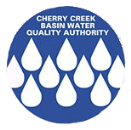CCR Inflow Concentrations
Cherry Creek flows from south to north to the reservoir through a 245,000 acre drainage basin. The basin includes various types of land use, including both agriculture and heavy development, as well as permitted discharges in and around Cherry Creek. Cottonwood Creek is the other major surface water input to Cherry Creek Reservoir. Cottonwood Creek has a much smaller watershed, more developed land use and no permitted discharges like Cherry Creek.
Why are CT-2 and CC-10 Important Monitoring Locations?
CT-2 and CC-10 are important monitoring locations because they allow us to understand what is flowing into the reservoir. Having an understanding of what is happening upstream of the reservoir is crucial in understanding the health of the reservoir.
Useful Links

Nitrogen Concentrations, CC-10 and CT-2
info_outlineEach point on this graph represents a sampling event. The different point colors represent different locations, while the filled and hollow icons indicate whether the parameter is total or dissolved. To learn more about a specific data point, hover over it with your mouse.
Phosphorus Concentrations, CC-10 and CT-2
info_outlineEach point on this graph represents a sampling event. The different point colors represent different locations, while the filled and hollow icons indicate whether the parameter is total or dissolved. To learn more about a specific data point, hover over it with your mouse.
Total Suspended Solids (TSS) Concentrations, CC-10 and CT-2
info_outlineEach point on this graph represents a sampling event. The different point colors represent different locations, while the filled and hollow icons indicate whether the parameter is total or dissolved. To learn more about a specific data point, hover over it with your mouse.
